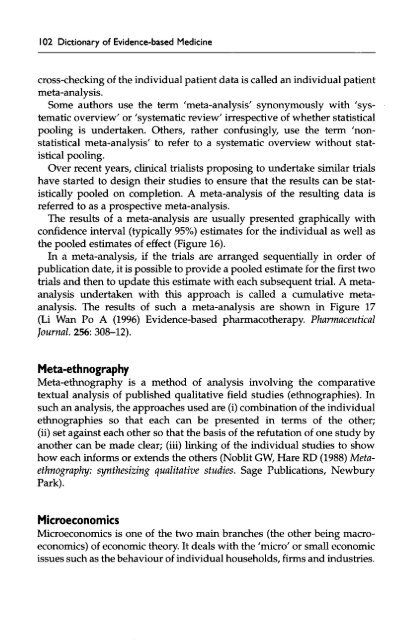Dictionary of Evidence-based Medicine.pdf
Dictionary of Evidence-based Medicine.pdf
Dictionary of Evidence-based Medicine.pdf
You also want an ePaper? Increase the reach of your titles
YUMPU automatically turns print PDFs into web optimized ePapers that Google loves.
102 <strong>Dictionary</strong> <strong>of</strong> <strong>Evidence</strong>-<strong>based</strong> <strong>Medicine</strong><br />
cross-checking <strong>of</strong> the individual patient data is called an individual patient<br />
meta-analysis.<br />
Some authors use the term 'meta-analysis' synonymously with 'systematic<br />
overview' or 'systematic review' irrespective <strong>of</strong> whether statistical<br />
pooling is undertaken. Others, rather confusingly, use the term 'nonstatistical<br />
meta-analysis' to refer to a systematic overview without statistical<br />
pooling.<br />
Over recent years, clinical trialists proposing to undertake similar trials<br />
have started to design their studies to ensure that the results can be statistically<br />
pooled on completion. A meta-analysis <strong>of</strong> the resulting data is<br />
referred to as a prospective meta-analysis.<br />
The results <strong>of</strong> a meta-analysis are usually presented graphically with<br />
confidence interval (typically 95%) estimates for the individual as well as<br />
the pooled estimates <strong>of</strong> effect (Figure 16).<br />
In a meta-analysis, if the trials are arranged sequentially in order <strong>of</strong><br />
publication date, it is possible to provide a pooled estimate for the first two<br />
trials and then to update this estimate with each subsequent trial. A metaanalysis<br />
undertaken with this approach is called a cumulative metaanalysis.<br />
The results <strong>of</strong> such a meta-analysis are shown in Figure 17<br />
(Li Wan Po A (1996) <strong>Evidence</strong>-<strong>based</strong> pharmacotherapy. Pharmaceutical<br />
Journal. 256: 308-12).<br />
Meta-ethnography<br />
Meta-ethnography is a method <strong>of</strong> analysis involving the comparative<br />
textual analysis <strong>of</strong> published qualitative field studies (ethnographies). In<br />
such an analysis, the approaches used are (i) combination <strong>of</strong> the individual<br />
ethnographies so that each can be presented in terms <strong>of</strong> the other;<br />
(ii) set against each other so that the basis <strong>of</strong> the refutation <strong>of</strong> one study by<br />
another can be made clear; (iii) linking <strong>of</strong> the individual studies to show<br />
how each informs or extends the others (Noblit GW, Hare RD (1988) Metaethnography:<br />
synthesizing qualitative studies. Sage Publications, Newbury<br />
Park).<br />
Microeconomics<br />
Microeconomics is one <strong>of</strong> the two main branches (the other being macroeconomics)<br />
<strong>of</strong> economic theory. It deals with the 'micro' or small economic<br />
issues such as the behaviour <strong>of</strong> individual households, firms and industries.










